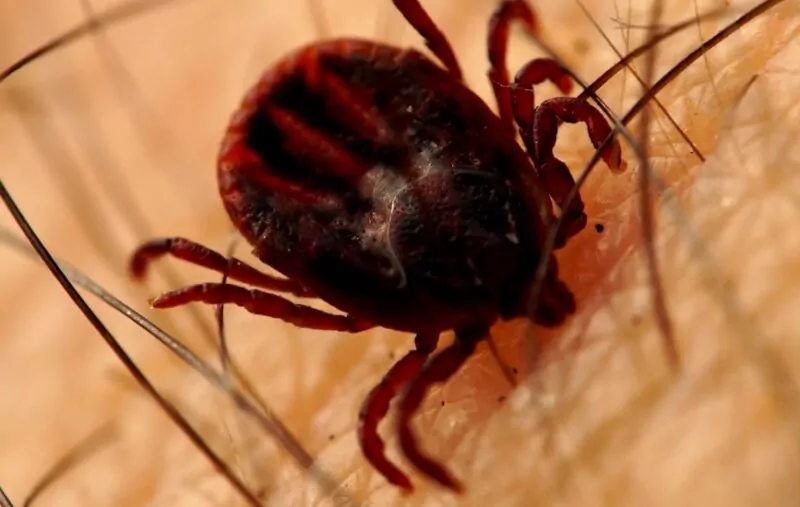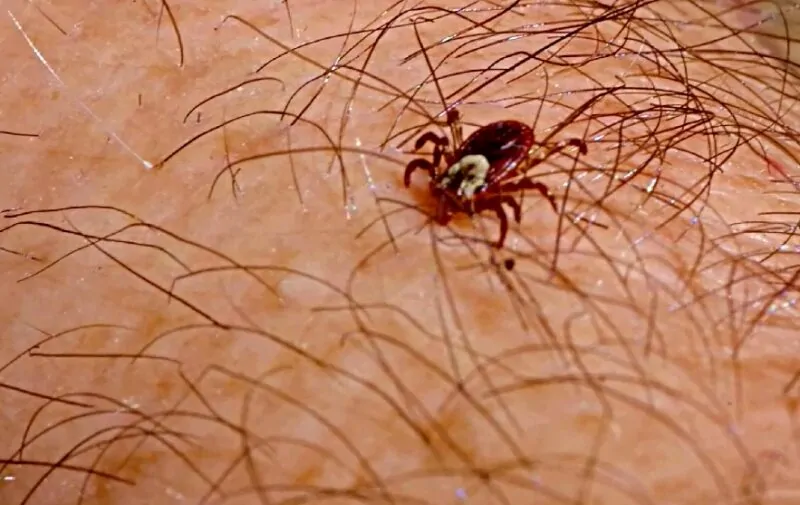If you’ve spent time outdoors in Iowa, chances are you’ve crossed paths with a tick or two. These tiny arachnids might seem harmless at first glance, but they carry serious health risks.
Let’s get into the details of the three most common tick species in Iowa: the blacklegged tick (also known as the deer tick), the American dog tick, and the lone star tick.
Each species is different and poses a unique threat due to the diseases they spread. I’m going to break down everything you need to know about them and offer some tips to help keep you and your loved ones safe.
Table of Contents
Toggle1. Blacklegged Tick (Ixodes scapularis)

What it looks like
The blacklegged tick, also called the deer tick, is pretty small. Adult females measure around 3–5 millimeters long, with reddish-brown bodies and dark legs.
What makes them tricky to spot is their size, especially in the juvenile stage (known as a nymph). Nymphs are about the size of a poppy seed — tiny enough to latch on without you even realizing it.
Where it likes to hang out
These ticks love dense, wooded areas, especially where deer are present. Therefore, Iowa is a perfect place for ticks and other bugs. So if you’re out hiking or even walking through a park with thick vegetation, you’re in their territory.
While they’re most active in the spring and fall, they can stay active on warmer winter days when temperatures creep above freezing.
Diseases they spread
Lyme Disease
As per the Mayo Clinic, Lyme disease is the big one here. It’s caused by Borrelia burgdorferi and often comes with flu-like symptoms and a “bull’s-eye” rash.
If untreated, Lyme disease can lead to joint pain, heart issues, and neurological complications.
Anaplasmosis
This one’s on the rise in Iowa. Caused by Anaplasma phagocytophilum, it brings fever, headache, and muscle aches — sometimes with stomach issues mixed in, according to Cleveland Clinic.
It’s no fun at all, but catching it early can help prevent serious complications.
Babesiosis
This is a rarer one but worth mentioning. According to the CDC, Babesiosis is caused by microscopic parasites that target red blood cells.
Most people feel like they’ve got the flu, but if you’ve got a weak immune system, it can hit hard.
2. American Dog Tick (Dermacentor variabilis)

How to identify it
Compared to the blacklegged tick, the American dog tick is noticeably larger. Females are between 5–15 millimeters in length, with brown bodies and white or cream-colored markings.
Males are a little smaller but carry similar markings. You’re more likely to spot one of these guys before it bites you — though, of course, it’s best to avoid that entirely.
Preferred hangouts
This tick prefers open fields, grassy meadows, and the edges of trails. If you’re venturing into places with low-lying vegetation, this is the tick to watch for.
They’re particularly active from late spring through summer, so keep that in mind during your next summer hike.
Diseases they spread
Rocky Mountain Spotted Fever (RMSF)
According to the New York Department of Health Fact Sheet, the American dog tick is a carrier of RMSF, which can be a killer if left untreated.
Early symptoms include fever, headache, and a rash that can spread all over. It’s a bacterial infection, so getting antibiotics quickly can make all the difference.
Tularemia
This is another bacterial infection, caused by Francisella tularensis. It’s not only spread by ticks but also by handling infected animals, as per WebMD.
Tick bites, however, can get into your system, leading to fever, swollen lymph glands, and painful skin ulcers.
3. Lone Star Tick (Amblyomma americanum)

Spotting one
The lone star tick gets its name from a distinct white “star” or dot on the back of adult females. Males lack the star but are also reddish-brown.
Adult females are around 4–6 millimeters long, making them easier to spot than the blacklegged tick but still small enough to be a sneaky pest.
Where they live
They thrive in wooded areas, particularly where underbrush is thick. If you’re in the woods during late spring or early summer, you’ve got a good chance of running into a lone star tick.
That said, they’re like many other ticks — they don’t hibernate as long as the temperature is warm enough for activity.
Diseases they spread

Ehrlichiosis
As per Mount Sinai, this bacterial infection is caused by Ehrlichia chaffeensis and can make you feel pretty lousy with fever, muscle pain, and headaches.
Sometimes, a rash appears, too. If not treated early, the infection can get much worse, so don’t delay if symptoms crop up after a tick bite.
Southern Tick-Associated Rash Illness (STARI)
While similar to Lyme disease in appearance (thanks to the rash), STARI is usually less severe. There’s still some mystery around it, but it’s thought to come from lone star tick bites.
Alpha-gal Syndrome (Red Meat Allergy)
This one’s a bit strange. According to Lauren Franzblau, M.D., after being bitten by a lone star tick, some people develop an allergy to red meat due to a sugar molecule called alpha-gal.
The result? Hives, stomach pain, or even life-threatening anaphylaxis after eating a steak. It’s become more common in recent years, so it’s good to be aware of.
The Rise of Tick-Borne Diseases in Iowa
Over the past decade or so, Iowa has seen a sharp increase in tick-borne diseases. Lyme disease cases have tripled since 2010, and that’s largely because the blacklegged tick population is growing — especially in eastern Iowa.
The state’s wooded areas provide the perfect environment for ticks to thrive. Lone star ticks and blacklegged ticks have also expanded their ranges, meaning diseases like anaplasmosis and ehrlichiosis are showing up in places they didn’t before.
How to Prevent Tick Bites
The good news? You don’t have to swear off outdoor adventures. There are plenty of steps you can take to lower your risk of getting a tick bite.
Here are some tips:
- Stick to trails: Stay in the middle of marked trails to avoid brushing against tall grass, bushes, or leaf litter, where ticks love to hide.
- Dress smart: Wear long sleeves, long pants, and closed-toe shoes when hiking or working in tick-prone areas. Tuck your pants into your socks for extra protection.
- Use tick repellents: Look for repellents with DEET for your skin and permethrin-treated clothing. Both can effectively keep ticks at bay.
- Check yourself and others: After a day outdoors, give yourself a thorough once-over. Pay attention to warm spots like your scalp, armpits, and behind your ears, where ticks love to hide.
- Know how to remove a tick: If you find one latched onto you, don’t panic. Grab some fine-tipped tweezers and pull the tick out gently but firmly. Avoid twisting or yanking, and be sure to clean the area afterward.
Final Thoughts
Ticks are no joke, especially with the diseases they carry becoming more widespread in Iowa. But by knowing what to look for, where they tend to hide, and how to prevent bites, we can enjoy the outdoors without the worry of picking up an unwelcome hitchhiker.
Stay safe, stay informed, and always do a tick check after your next adventure. Keep those tips handy, share them with others, and remember — ticks may be small, but they can have a big impact.
It’s better to be cautious and keep yourself tick-free than deal with the potential health consequences later on.















